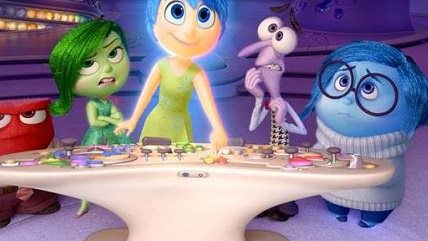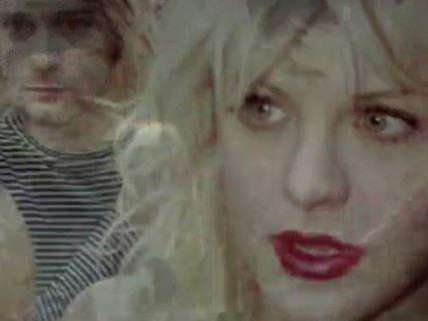Movie Reviews: Inside Out and Soaked in Bleach
Pixar animation back in top form, and the Kurt Cobain case continues to fester.


A little girl is born; her parents name her Riley. Bending down over her bassinet, mom and dad gaze into their new baby's eyes. Inside Riley's head—her Headquarters—five fledgling emotions gaze back. They're gathered at an elaborate control console, ready to begin their job, which will of course last a lifetime.
Inside Out is a return to classic form for Pixar Animation Studios, and a storytelling triumph for Pixar star Pete Docter (who also directed Monsters, Inc. and Up, and cowrote Toy Story and WALL-E). Working with writers Ronnie Del Carmen, Meg LeFauve, and Josh Cooley, Docter has fashioned a tale that's dizzyingly inventive, filled with daffy situations, crackerjack lines, and moving truths about human nature. The movie is an all-ages marvel.
As Riley grows happily toward adolescence in suburban Minneapolis, her Headquarters is dominated by blue-haired Joy, a manic optimist ("Find the fun!"). But Joy (voiced with whiplash precision by Amy Poehler) struggles to control her fellow emotions: gloomy Sadness (Phyllis Smith), fidgety Fear (Bill Hader), acid-tongued Disgust (Mindy Kaling) and hot-headed Anger (Lewis Black). Joy manages to maintain a sunny outlook for Riley (Kaitlyn Dias) for 11 years—until one day her mother (Diane Lane) and father (Kyle MacLachlan) announce a move to San Francisco, where dad has a new job waiting. Suddenly, trouble clouds move in.
Pixar is based in the Bay Area, and it's amusing to find that the San Francisco we see here is a little grim. There are hellish traffic jams ("These are my kind of people!" Anger exults), and Riley's new house is dark and unwelcoming. Joy helps Riley make the best of it, but when she and Sadness are suddenly drawn away from Headquarters and out into the wilder regions of Riley's mind, the remaining emotions take over, with chaotic results.
The movie keeps us fully briefed on Riley's new life, but most of the action takes place inside her head, where her accumulating memories roll into Headquarters in the form of glowing, bowling-ball-size globes. Ranged around outside the Headquarters tower are a series of islands representing aspects of Riley's developing personality: Friendship Island, Honesty Island, the delirious Goofball Island. When Fear, Disgust, and Anger are left to man the Headquarters controls, the islands begin to tremble. Will Joy and Sadness make it back in time to avert disaster?
Hopping aboard a Train of Thought, these two soon find themselves passing through places like Long Term Memory, the wacky world of Abstraction, and the scary depths of the Subconscious. Their adventures in these realms are rendered in the sleek, hyper-saturated Pixar style, every gesture and burst of action worked out in dazzling detail. And the movie's emotional design is also trademark Pixar. At one point, Joy and Sadness encounter an Imaginary Childhood Friend named Bing Bong (Richard Kind), who's part elephant and part dolphin—and who realizes that he's slowly being forgotten by his onetime real-world pal.
In the spirit of taunting puppies and stomping kittens, I would also say that the adventures of Joy and Sadness are sometimes overextended—toward the end, the colorful pandemonium occasionally begins to wear. But that's a minor nit to pick in a movie whose sole flaw is that it might be too much of a good thing.

Soaked in Bleach
Who killed Kurt Cobain? The official verdict is: he did. Sometime around April 5, 1994, the Nirvana leader injected himself with a massive overdose of heroin at his Seattle home and then used a shotgun to finish the job. Almost immediately after Cobain's body was discovered, on April 8, Seattle police announced that he had committed suicide.
But 21 years later, a large and vocal contingent of Nirvana fans and true-crime aficionados continues to insist that Cobain was murdered, in a scheme overseen by his wife, Hole leader Courtney Love, who feared that her husband was about to divorce her and write her out of his will.
This version of events has already been probed by Nick Broomfield in his 1998 documentary Kurt & Courtney. Now, in the new film Soaked in Bleach, first-time director Benjamin Statler revisits the case, once again with ambiguous results. The story is still provocative, but Statler has nothing new to add to it.
Statler relies heavily on the assertions of Tom Grant, the private investigator Courtney hired to find Cobain after he disappeared from a Los Angeles rehab facility just days before his body was found. Grant, also featured in Broomfield's documentary, is this film's main talking head, as well as a character (played by actor Daniel Roebuck) in its many reenacted scenes. If the picture made any gesture in the direction of objectivity (not that there's any reason it should have to), these scenes would undermine it. They're clearly scripted, with the faux Grant and Courtney (Sarah Scott, in a diaphanous negligee) conversing at length in her bedroom. Since these conversations are undocumented, we have only Grant's word that they happened the way he says they did. (Although when he claims that Courtney was either doing drugs or on drugs whenever he spoke to her, this is instantly believable.)
Grant taped all of his phone conversations with Love. Some of them rouse suspicions, and none of them stir any sympathy for her. (Brash and blowsy, she is, shall we say, a divisive music-scene figure.) However, when one tape is played twice so that we can hear Courtney saying, "The people I had do this, I paid," we immediately realize that she's not talking about Cobain's death—the line has been hammered home to thicken the film's atmosphere of dark treachery. Similarly, interviews with old friends of Cobain in his home town of Aberdeen, Washington, tell us very little. One of these friends says he never thought of Cobain as suicidal ("He always seemed happy")—but then that was long before he and his band were swamped by stardom.
With its rainy nightscapes and other film-noir flourishes, Statler's picture plays like a minor homage to Errol Morris's true-crime classic The Thin Blue Line. But that movie got a man off death row. Despite the torrent of innuendo directed at Love and one of Cobain's friends and one employee, nothing is nailed down (which hasn't dissuaded Love from having cease-and-desist orders served on theatres planning to screen the film). The only direct hit the picture lands is on the Seattle Police Department, which—among several things—took a month to process Cobain's shotgun for fingerprints, and never even developed four rolls of film used to photograph the crime scene. The SPD now says it did reexamine the evidence in the case last year, and it finally developed that film (although not all of the resulting photos have been made public). Conclusion: still suicide. When forensic pathologist Cyril Wecht, best known for his assault on the Warren Commission's Kennedy-assassination report, weighs in here to call for a reinvestigation of Cobain's death—and to urge that Seattle police play no part in it—it's hard not to see this as the best way to deal with the public doubts that still linger after all these years.
I must mention that I pop up in this film at a couple of points, in old MTV footage, exemplifying the feckless media that swallowed whole the suicide narrative retailed by Love and the SPD. Why did we not conduct our own investigations to reveal the ugly facts of Cobain's death? There's something to this: credulous journalists have often been led around by the nose by manipulative sources. That said, though, there's a difference between reporting on an event at the time it happens, relying on what little information may be known, and later launching a full-scale inquiry at great cost in time and money, which is usually unforthcoming. In any case, Cobain's death has been investigated—by Grant, by Broomfield, and now by Statler, among others. And still, no conclusions have been reached. Like the Kennedy assassination, the Cobain case is unlikely ever to be explained to everyone's satisfaction.
Show Comments (61)